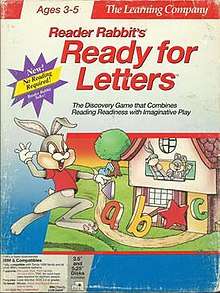Reader Rabbit's Ready for Letters
Reader Rabbit's Ready for Letters is a 1992 video game and the fifth game of the Reader Rabbit franchise. Although a spin-off title, it is designed for ages 3 to 6 to teach prereaders about becoming literate and phonics.
| Reader Rabbit's Ready for Letters | |
|---|---|
 DOS Cover art | |
| Developer(s) | The Learning Company |
| Publisher(s) | The Learning Company |
| Designer(s) | Lauren Elliott |
| Series | Reader Rabbit |
| Platform(s) | DOS, Macintosh |
| Release |
|
| Genre(s) | Edutainment |
| Mode(s) | Single-player |
Educational Goals
The game was designed with a re-usability value, which help children develop new language skills and sharpen old ones.[2] The game allows for free exploration and offers activities that enable children to begin learning to read.[3] The modules included teach shape recognition, matching and basic word skills.[1] The digitized voices encourage direction, exercises listening comprehension and helps tie language to words. The concept of cause-and-effect is implemented.[2] The activities expose prereaders to letters, simple words, word relationships, creativity, colors, shapes and matching.[4] Music and animations add to retain interest.[5]
Gameplay
The game takes place in the house and garden of Grandma and Grandpa Rabbit. There are two modes during gameplay; the free-form mode, which allows players to do the activities are in their own way and the goal-based mode, which instructs the player what to do. The game consists of six activities:[6]
- The Music Pond
- Grandma's Kitchen
- The Mix-and-Match Bedroom
- The ABC Bathroom
- The Picture Parlor
- Grandpa's Workshop
Reception
| Reception | ||||||
|---|---|---|---|---|---|---|
| ||||||
| ||||||
The Managing Editor of PCM Magazine Sue Fomby highlighted the game for its gameplay that helped children to start reading.[3] MacUser gave the game 2 and a half stars, being suited for the youngest and lesser experienced prereaders.[7]
References
- "Industry News". Computer Gaming World. No. 79. Ziff Davis. August 1992. p. 94.
- Aycock, Heidi E. H. (November 1992). "Listen to your Elders". PC Games. IDG. pp. 34, 36.
- The Learning Company Product Catalog 1994
- Toroussian, Jasmin (December 1993). "Help Kids Key into Computers". Computer Gaming World. No. 113. Ziff Davis. p. 178.
- "Educational Games move Forward". Electronic Games. Vol. 1 no. 1. Decker Publications. October 1992. p. 65.
- Eiser, Leslie (November 1992). "Reader for Letters - Gamebytes". Game Players PC Entertainment. Vol. 5 no. 6. GP Publications. p. 6.
- Myslewski, Rik; Shatz-Akin, Jim (December 1994). "The Ultimate Guide to Children's Software" (PDF). MacUser. Vol. 12 no. 9. Ziff Davis. p. 98.